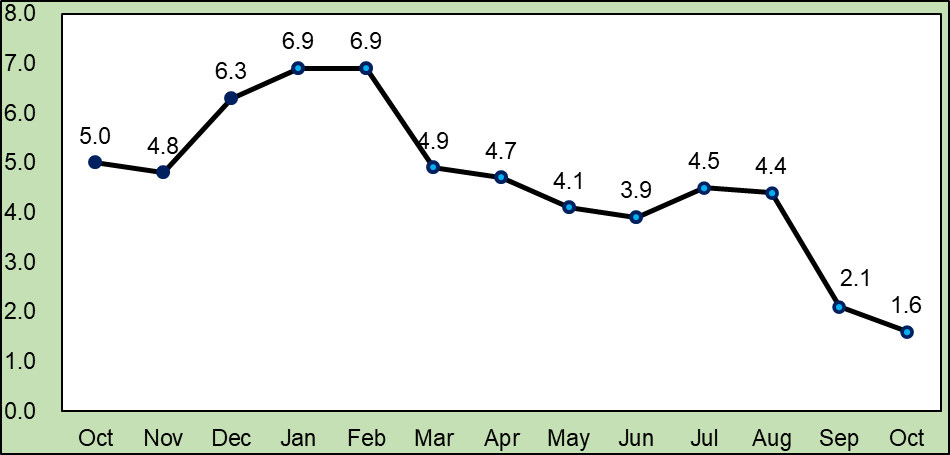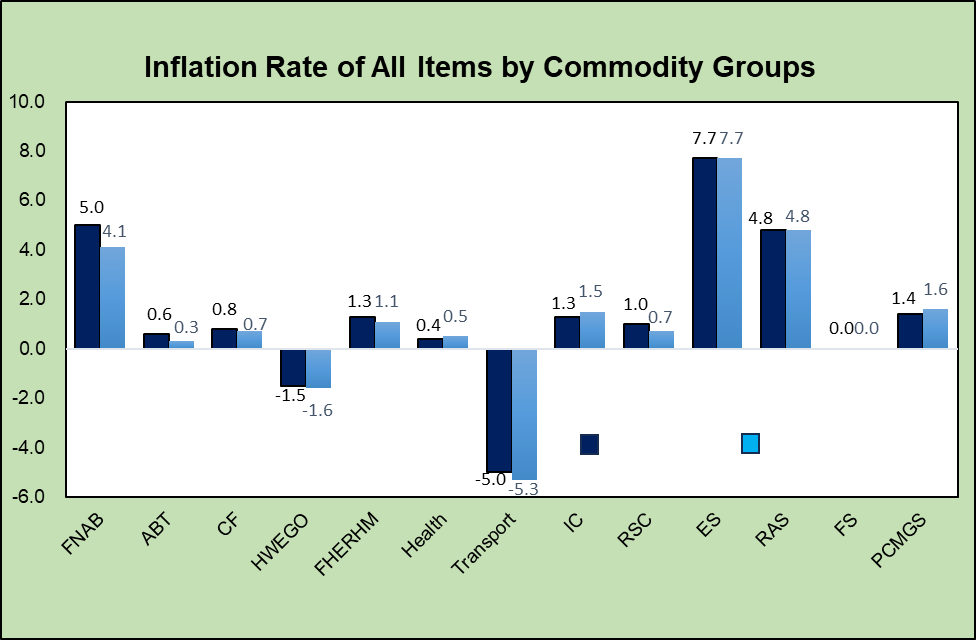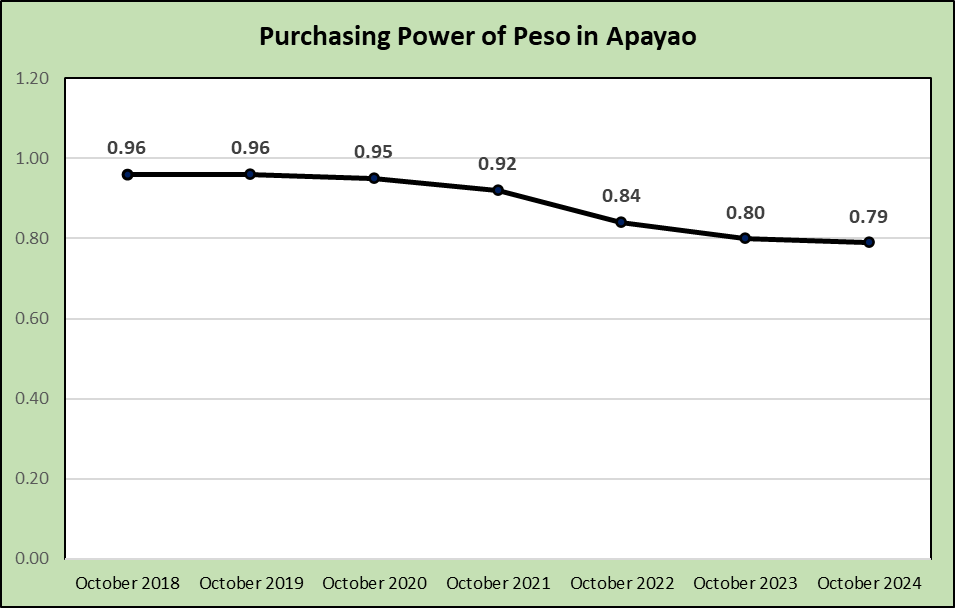Inflation Rate decelerated to 1.6 percent in October 2024
Table 1. Year-on-Year Inflation Rates in Apayao Province, All Items in Percent October 2024 (2018=100)
October 2023 | September 2024 | October 2024 | Year-to-date |
5.0 | 2.1 | 1.6 | 4.4 |
Source: Retail Price Survey of Commodities for the Generation of Consumer Price Index, Philippine Statistics Authority
The province’s inflation rate decelerated to 1.6 percent in October 2024 from 2.1 percent in September 2024. It is lower by 3.4 percentage points compared with the same month of the previous year at 5.0 percent and 0.5 percentage point lower than September 2024 at 2.1 percent. (Table 1 and Figure 1)
Figure 1. Year-on Year Inflation Rate, All Items in Percent, October 2023 – October 2024 (2018=100)

Source: Retail Price Survey of Commodities for the Generation of Consumer Price Index, Philippine Statistics Authority
Table 2. Year-on-Year Consumer Price Index in Apayao, By Commodity Groups in Percent (2018=100)
Commodity Groups | October 2023 | September 2024 | October 2024 |
ALL ITEMS | 124.3 | 126.4 | 126.3 |
I. Food and Non-Alcoholic Beverages | 122.0 | 127.2 | 127.0 |
II. Alcoholic Beverages and Tobacco | 159.5 | 159.6 | 160.0 |
III. Clothing and Footwear | 120.9 | 121.7 | 121.8 |
IV. Housing, Water, Electricity, Gas and Other Fuels | 128.7 | 126.8 | 126.7 |
V. Furnishing, Household Equipment and Routine Household Maintenance | 114.9 | 116.2 | 116.2 |
VI. Health | 113.8 | 114.2 | 114.4 |
VII. Transport | 136.6 | 129.8 | 129.3 |
VIII. Information and Communication | 103.4 | 104.7 | 104.9 |
IX. Recreation, Sport and Culture | 136.2 | 137.1 | 137.1 |
X. Education Services | 109.4 | 117.8 | 117.8 |
XI. Restaurants and Accommodation Services | 151.0 | 158.2 | 158.2 |
XII. Financial Services | 146.0 | 146.0 | 146.0 |
XIII. Personal Care, and Miscellaneous Goods and Services | 116.8 | 118.3 | 118.7 |
Source: Retail Price Survey of Commodities for the Generation of Consumer Price Index, Philippine Statistics Authority
The overall CPI increased from 124.3 of the same month of the previous year to 126.3 in October 2024, representing a 1.6 percent inflation rate. The data shows that the value of goods amounting to 100 pesos in the base year 2018 values 124.30 pesos in October 2023; 126.40 pesos in September 2024; and 126.30 pesos in October 2024. When the CPI decreases, it indicates that the average price level of goods and services has also decreased, and vice versa. (Table 2)
Table 3. Year-on-Year Inflation Rates in Apayao, By Commodity Groups in Percent (2018=100)
Commodity Groups | October 2023 | September 2024 | October 2024 |
ALL ITEMS | 5.0 | 2.1 | 1.6 |
I. Food and Non-Alcoholic Beverages | 9.5 | 5.0 | 4.1 |
II. Alcoholic Beverages and Tobacco | 5.6 | 0.6 | 0.3 |
III. Clothing and Footwear | 4.4 | 0.8 | 0.7 |
IV. Housing, Water, Electricity, Gas and Other Fuels | 1.3 | -1.5 | -1.6 |
V. Furnishing, Household Equipment and Routine Household Maintenance | 0.4 | 1.3 | 1.1 |
VI. Health | 0.1 | 0.4 | 0.5 |
VII. Transport | -3.1 | -5.0 | -5.3 |
VIII. Information and Communication | 0.6 | 1.3 | 1.5 |
IX. Recreation, Sport and Culture | -1.3 | 1.0 | 0.7 |
X. Education Services | 0.0 | 7.7 | 7.7 |
XI. Restaurants and Accommodation Services | 7.2 | 4.8 | 4.8 |
XII. Financial Services | 0.0 | 0.0 | 0.0 |
XIII. Personal Care, and Miscellaneous Goods and Services | 0.6 | 1.4 | 1.6 |
Source: Retail Price Survey of Commodities for the Generation of Consumer Price Index, Philippine Statistics Authority
The commodity groups which had the highest percentage share in the downtrend during the period are as follows:
Food and Non-Alcoholic Beverages, which accounted for 4.1 percent and had an 87.7 percent share in the overall trend;
Transport, which accounted for -5.3 percent and had a 5.2 percent share in the overall trend;
Housing, Water, Electricity, Gas and Other Fuels, which accounted for -1.6 percent and had a 3.2 percent share in the overall trend;
Furnishings, Household Equipment and Routine Household Maintenance, which accounted for 1.1 percent and had a 1.2 percent share in the overall trend;
Alcoholic Beverages and Tobacco, which accounted for 0.3 percent and had a 1.2 percent share in the overall trend;
Clothing and Footwear which accounted for 0.7 percent and had a 1.0 percent share in the overall trend; and
Recreation, Sport and Culture, which accounted for 0.7 percent and had a 0.5 percent share in the overall trend.
(Table 3 and Figure 2)
Moreover, the following commodity sub-class which had the highest percent share in the trend during the month of October 2024 are:
- Rice with 67.2 percent;
- Eggs of hen and other birds in shell, fresh with 11.0 percent;
- Liquefied hydrocarbons (butane, propane, etc.) delivered in storage containers with 2.8 percent;
- Diesel with 2.5 percent;
- Coffee with 2.3 percent;
- Bananas, fresh with 2.1 percent;
- Gasoline with 1.8 percent;
- Furnishings, loose carpets and rugs with 1.2 percent;
- Garments for women or girls with 0.7 percent;
- Spirits and liquors with 0.7 percent;
- Corn with 0.7 percent;
- Tunas, skipjack or stripe-bellied bonito, prepared or preserved with 0.6 percent;
- Tire repair, tire change with 0.6 percent;
- Coconuts, fresh with 0.5 percent;
- Writing materials with 0.4 percent;
- Products and materials, such as paints and varnishes, renderings, wallpapers, fabric wall coverings, window panes, plaster, cement, putty, wallpaper pastes, etc., purchased for minor maintenance and repair of the dwelling with 0.4 percent;
- Cigarettes with 0.3 percent;
- Other fish, dried, salted, in brine, smoked with 0.3 percent;
- Freshwater fish, live, fresh, chilled, or frozen with 0.3 percent;
- Other food products n.e.c. with 0.3 percent;
- Footwear for men including sports footwear with 0.3 percent;
- Fruit and vegetables juices, powder with 0.3 percent;
- Soft drinks with 0.3 percent;
- Spices, culinary herbs and seeds with 0.3 percent;
- Macaroni, noodles, couscous and similar pasta products with 0.2 percent;
- Baby formula with 0.2 percent;
- Engine overhaul with 0.2 percent;
- Flour of wheat with 0.1 percent;
- Other cereal and grain mill products with 0.1 percent;
- Beer with 0.1 percent;
- Concentrates and ready to drink juice with 0.1 percent;
- Other fish, prepared or preserved with 0.1 percent; and
- Cephalopods, prepared or preserved with 0.1 percent.
However, the commodity groups which increased in their inflation rate are:
- Personal Care and Miscellaneous Goods and Services which increased by 0.2 percentage points;
- Information and Communication which increased by 0.2 percentage points;
- Health which increased by 0.1 percentage point. (Table 3 and Figure 2)
On the other hand, the commodity groups with constant inflation compared to the previous month are Restaurants and Accommodation, Education Services, and Financial Services. (Table 3 and Figure 2)

Source: Retail Price Survey of Commodities for the Generation of Consumer Price Index, Philippine Statistics Authority
Purchasing Power of Peso (PPP) recorded at 0.79 in October 2024
Purchasing power of peso continues to weaken through the years and reached 0.79 in October 2024. The PPP of 0.79 implies that the Php1.00 in the base year 2018 values only Php 0.79 in October 2024. A low purchasing power signifies that the currency has depreciated in value and can acquire a reduced amount of goods and services. Conversely, a high purchasing power of the peso indicates that the currency can purchase a greater quantity of goods and services. (Figure 3)
Figure 3. Purchasing Power of Peso in Apayao (2018=100): October 2018 – October 2024

Source: Retail Price Survey of Commodities for the Generation of Consumer Price Index, Philippine Statistics Authority
DEFINITION OF TERMS
Consumer Price Index (CPI) measures the overall change in consumer prices based on a representative basket of goods and services over time.
Inflation refers to an overall increase in the Consumer Price Index (CPI), which is a weighted average of prices for different goods.
Purchasing power of the peso shows how much the peso in the base period is worth in the current period. It is computed as the reciprocal of the CPI for the period under review multiplied by 100.
Commodity Groups are group of goods and services found in the market basket of the province. There are thirteen (13) commodity groups which were arranged according to the PCOICOP.
FNAB stands for Food and Non-Alcoholic Beverages
ABT stands for Alcoholic Beverages and Tobacco
CF stands for Clothing and Footwear
HWEGO stands for Housing, Water, Electricity, Gas, and Other Fuels
FHERHM stands for Furnishings, Household Equipment and Routine Household Maintenance
IC stands for Information and Communication
RSC stands for Recreation, Sport, and Culture
ES stands for Education Services
RAS stands for Restaurants and Accommodation Services
FS stands for Financial Services
PCMGS stands for Personal Care, Miscellaneous Goods and Services
Approved by:

GEOFFREY B. CALIMUHAYAN
Chief Statistical Specialist
CBB/ LSBT
Source: Retail Price Survey of Commodities for the Generation of Consumer Price Index, Philippine Statistics Authority

